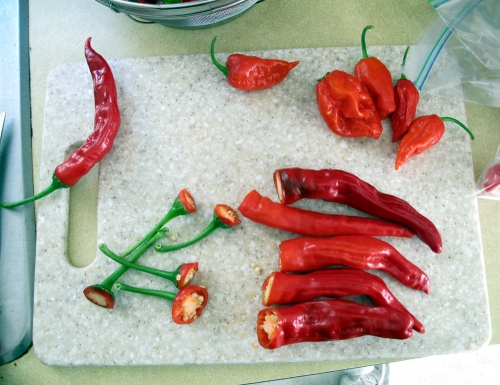By Sara Bonisteel, CNN
http://www.cnn.com/2010/LIVING/homestyle/04/14/chile.heads.seek.heat/?hpt=Sbin
(CNN) — India may be turning the world’s hottest chili into a weapon, but there are people who actually want to eat the ghost chili — the bhut jolokia or naga jolokia — for fun.
“As soon as something is declared and proven to be the hottest chili pepper in the world, everybody wants to grow it,” said Dave DeWitt, the author of more than 35 books on chilis, including “The Complete Chile Pepper Book.”
“So they can take people out in their yard and say, ‘That is the hottest chili pepper in the world. Do you dare eat it?’ ”
A small but dedicated group of chili pepper lovers fosters its devotion to heat on Web sites and at festivals nationwide.
They gather at annual events such as the Chile Pepper Food Festival in Bowers, Pennsylvania, an autumn affair that features a pepper-eating contest, naturally, but also a song contest and excursions into the fields where fans can see how their favorite peppers are grown.
In their homes, fans congregate for “hotlucks,” the traditional potluck with exponentially higher heat.
Mark Stevens of Monmouth County, New Jersey, is among these self-proclaimed “chili-heads.”
“The main issue is flavor,” Stevens said. “It’s not a pissing contest to see who can eat the hottest thing, which is usually what you see when the media reports on the stuff.”
Once an eater gets used to the heat, he or she begins to appreciate the flavor differences of each varietal, Stevens says.
“You basically build up a tolerance to the heat and then can taste all the flavors that are underneath it, so that what was just basically flavorless blazing heat, after a while, you can actually taste the different flavors in different chilis in different foods,” he said.
Stevens says he began eating chilis in the early 1990s when he needed to lose weight. “I wanted something that I could snack on that was pretty low-calorie but definitely let me know that I had eaten something, and chilis kind of fit the bill.”
Dave Hirschkop has been selling hot sauces for 17 years through his company, Dave’s Gourmet, and says it’s the hottest sauces that are his best sellers.
“There are a lot of people that just want to challenge themselves,” Hirschkop said. “They want to see what the hottest thing in the world is, either because they’re daredevils or because their heat tolerance is amazingly high and to get that reaction they like, they need something that’s super strong.”
Hirschkop sells two sauces made with the ghost chili, a pepper so hot it rates about 1 million on the Scoville unit system. Tabasco comes in at around 5,000.
The Indian government said last month that it planned to use the ghost pepper in a tear gas-like hand grenade aimed at fighting terrorists or rioters.
Making a weapon is “probably one of the best things you can do with them,” DeWitt said.
The peppers get their heat from capsaicin, a chemical that the plants have developed to keep mammals from eating them (mammals destroy the seeds in the digestion process). Birds, which can eat the peppers and pass the seeds through their system, are immune to the heat of capsaicin.
The people who really like to eat the super-hot chilis probably don’t have as many capsaicin receptors in their mouths, DeWitt says.
It’s the fiery reaction that Dave’s Gourmet customers are searching for. Hirschkop puts the ghost chili in one of his “Insanity” sauces as well as in a limited-edition hot sauce he sells in a wooden coffin tied shut with caution tape.
“This one has a great flavor but is the hottest in the world; that’s the bottom line, right?” he said. “People aren’t talking about some cascabel [chili] or some other variety with that enthusiasm.”





































